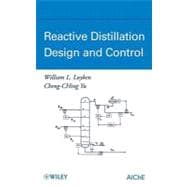
William L. Luyben, PHD, is Professor of Chemical Engineering at Lehigh University. In addition to forty years of teaching, Dr. Luyben spent nine years as an engineer with Exxon and DuPont. He has written nine books and more than 200 papers. He was the 2004 recipient of the Computing Practice Award from the CAST Division of the AIChE and was elected in 2005 to the Process Automation Hall of Fame. CHENG-CHING YU, PHD, has spent sixteen years as a Professor at National Taiwan University of Science and Technology and four years at National Taiwan University. He has published over 100 technical papers in the areas of plant-wide process control, reactive distillation, control of microelectronic processes, and modeling of fuel cell systems.
| Introduction | |
| History | |
| Basics of Reactive Distillation | |
| Neat Operation versus Excess Reactant | |
| Limitations | |
| Scope | |
| Computational Methods | |
| References | |
| Steady-State Design Of Ideal Quaternary System | |
| Parameter Effects | |
| Effect of Holdup on Reactive Trays | |
| Effect of Number of Reactive Trays | |
| Effect of Pressure | |
| Effect of Chemical Equilibrium Constant | |
| Effect of Relative Volatilities | |
| Effect of Number of Stripping and Rectifying Trays | |
| Effect of Reactant Feed Location | |
| Conclusion | |
| Economic Comparison of Reactive Distillation with a Conventional Process | |
| Conventional Multi-Unit Process | |
| Reactive Distillation Design | |
| Results for Different Chemical Equilibrium Constants | |
| Results for Temperature-Dependent Relative Volatilities | |
| Conclusion | |
| Neat Operation versus Using Excess Reactant | |
| Introduction | |
| Neat Reactive Column | |
| Two-Column System with Excess B | |
| Two-Column System with 20 0.000000E+00xcess A | |
| Economic Comparison | |
| Conclusion | |
| Steady-State Design Of Other Ideal Systems | |
| Ternary Reactive Distillation Systems | |
| Ternary System without Inerts | |
| Ternary System with Inerts | |
| Conclusion | |
| Ternary Decomposition Reaction | |
| Intermediate Boiling Reactant | |
| Heavy Key Reactant with Two Column Configuration | |
| Heavy Key Reactant with One Column Configuration | |
| Conclusion | |
| Steady-State Design Of Real Chemical Systems | |
| Steady-State Design for Acetic Acid Esterification | |
| Reaction Kinetics and Phase Equilibrium | |
| Process Flowsheets | |
| Steady-State Design | |
| Process Characteristics | |
| Discussion | |
| Conclusion | |
| Design of TAME Reactive Distillation Systems | |
| Chemical Kinetics and Phase Equilibrium | |
| Component Balances | |
| Effect of Parameters on Reactive Column | |
| Pressure-Swing Methanol Separation Section | |
| Extractive Distillation Methanol Separation Section | |
| Economic Comparison | |
| Conclusion | |
| Design of MTBE and ETBE Reactive Distillation Columns | |
| MTBE Process | |
| ETBE Process | |
| Conclusion | |
| Control Of Ideal Systems | |
| Control of Quaternary Reactive Distillation Columns | |
| Introduction | |
| Steady-State Design | |
| Control Structures | |
| Selection of Control Tray Location | |
| Closedloop Performance | |
| Using More Reactive Trays | |
| Increasing Holdup on Reactive Trays | |
| Rangeability | |
| Conclusion | |
| Control of Excess-Reactant System | |
| Control Degrees of Freedom | |
| Single Reactive Column Control Structures | |
| Control of Two-Column System | |
| Conclusion | |
| Control of Ternary Reactive Distillation Columns | |
| Ternary System without Inerts | |
| Ternary System with Inerts | |
| Ternary Aa??B+C System: Intermediate Boiling Reactant | |
| Ternary Aa??B+C System: Heavy Reactant with Two-Column Configuration | |
| Ternary Aa??B+C System: Heavy Reactant with Single Column | |
| Control Of Real Systems | |
| Control of MeAc/ EtAc/IPAc/BuAc/AmAc Systems | |
| Process Characteristic | |
| Control Structure Design | |
| Extension to Composition Control | |
| Conclusion | |
| Control of TAME Plantwide Process | |
| Process Studied | |
| Control Structure | |
| Results | |
| Conclusion | |
| Chapter | |
| Table of Contents provided by Publisher. All Rights Reserved. |
The New copy of this book will include any supplemental materials advertised. Please check the title of the book to determine if it should include any access cards, study guides, lab manuals, CDs, etc.
The Used, Rental and eBook copies of this book are not guaranteed to include any supplemental materials. Typically, only the book itself is included. This is true even if the title states it includes any access cards, study guides, lab manuals, CDs, etc.